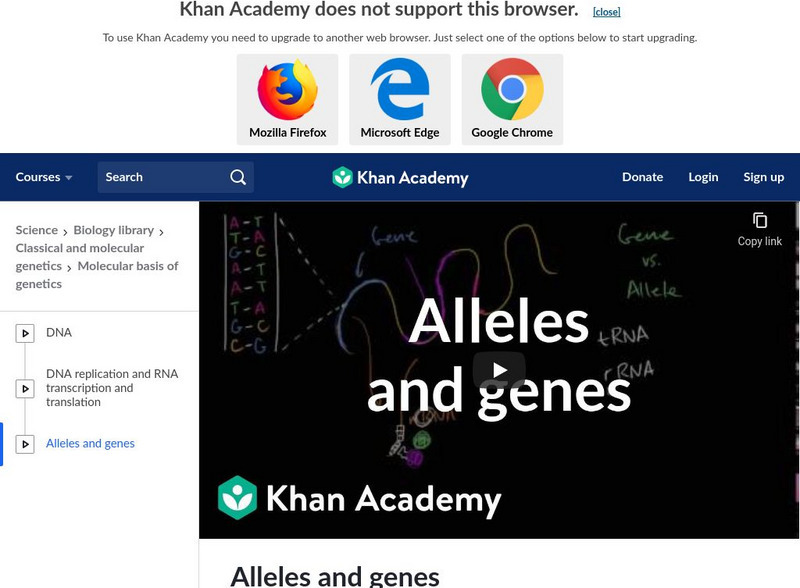Hi, what do you want to do?
Khan Academy
Introduction to Heredity
Young scientists generally love to learn how certain traits can be explained by a direct combination of alleles from their parents. Here, they can examine how a phenotype is often expressed when one allele is recessive and the other is...
Khan Academy
Variation in a Species
If there are no extenuating environmental factors to ensure competition in a species, then variation is achieved by random mutation. This resource may be more useful after viewers are introduced to the concepts of alleles and the...
Amoeba Sisters
Alleles and Genes
How do organisms end up with such a wide variety of traits? It's in their genes! Kick off your inherited traits lesson using a brief video that covers alleles and genes. The narrator describes heterozygous and homozygous genotypes, how...
Amoeba Sisters
Pedigrees
Pupils puzzled by pedigree charts? Not anymore! Show them proper pedigree protocol using a short video from an excellent biology playlist. Content includes pedigree symbols and terminology, interpreting pedigrees of various lengths, and...
FuseSchool
What Is Cystic Fibrosis?
Can just anyone develop cystic fibrosis? Examine the symptoms, treatment, and life expectancy of cystic fibrosis patients through a video from an engaging biology series. Topics include the genetics behind the illness, when in life...
FuseSchool
Genetics and Cell Division Keyword Definitions
Scholars often find new vocabulary overwhelming—help break it down for them. A helpful video addresses the vocabulary associated with genetics and cell division. It offers the definition of each and a short explanation. Cartoon graphics...
FuseSchool
Codominance
Some alleles share codominance rather than dominant or recessive. The video explains how codominance is determined and what it looks like in animals. Part of the Fuse School Genetics series, it relates the topic to human blood types and...
Teacher's Pet
Allele Frequencies
One way scientists describe diversity in a population is through allele frequencies. The video explains how to perform these simple calculations. Then it presents the Hardy-Weinberg assumptions and the difference between acclimation and...
Teacher's Pet
Gregor Mendel
What did Gregor Mendel say when he founded genetics? Woopea! The video introduces Gregor Mendel to viewers. It details his initial experiments with peas and his understanding of genetics.
Bozeman Science
Genetic Drift
Male northern elephant seals grow to be 13 feet in length and can weigh up to 4,500 pounds. In the video, scholars explore genetic drift in a population through a simulation. The instructor shows allele frequencies changing over time,...
Bozeman Science
Solving Hardy-Weinberg Problems
What is a gene pool? What do gene pools have to do with the Hardy-Weinberg formula? How was this formula derived? After viewing a video that introduces these concepts, young scientists determine p and q values and then work sample...
Bozeman Science
Microevolution
If some genes were exposed to microwaves, would that cause microevolution? In the video, scholars learn about microevolution or any change in the allele frequency of a population. The instructor explains the five ways microevolution...
Bozeman Science
Mendelian Genetics
Young scientists explore Gregor Mendel's work on pea plants, his laws of segregation and independent assortment. They work through genetic problems and then finish by looking at Huntington's disease and genetic testing.
Bozeman Science
Hardy-Weinberg Equation
Dark, curly, non-red, and thick hair are all dominant genes. The video begins by defining phenotype, genes, alleles, and genotype. Scholars learn how alleles determine genotype, which directs phenotype, using red hair as the example. The...
Crash Course
Heredity
Ear wax, either wet or dry, is inherited on chromosome 16. The narrator of a video about heredity uses ear wax to introduce the concepts of alleles, dominant and recessive traits, and heterozygous and homozygous genotypes.
Crash Course
Population Genetics: When Darwin Met Mendel
Learners explore population genetics, or how populations of species change over time, leading to evolution with a video that brings together the principles of Mendel and Darwin and explains and models the Hardy-Weinberg equation.
Amoeba Sisters
Monohybrids and the Punnett Square Guinea Pigs
Introduce young biologists to monohybrid crosses and simple Punnett Squares. It includes explanations of dominant versus recessive and genotype versus phenotype by exploring different genetic combinations of guinea pigs.
Amoeba Sisters
Natural Selection and the Bacterial Resistance
Biological fitness involves the number of offspring you produce and is not dependent on working out. The video explains natural selection using cartoon graphics of frogs on a log. Then it introduces evolution through antibiotic...
Amoeba Sisters
Punnett Squares and a Dihybrid Cross
Cats have a reputation for avoiding water, but did you know many cats love sinks? A video explains how to solve 16-square Punnett square problems with a dihybrid cross. It includes Mendel's Law of Segregation and Mendel's Law of...
TED-Ed
Why Do Blood Types Matter?
Here is a fascinating video that explores the genetic implications of our blood types as humans, how we can determine an individual's blood type based on cell alleles, the RH factor, and how blood types can mean life or death for those...
Curated OER
Genetics and The Structure of DNA - Part 1/2
If you could unravel all the DNA in your body and stretch it out, it would reach to the sun and back...over 100 times! How incredible! Cover basic genetic vocabulary and hear a geneticist speak about your body's internal recipe....
PBS
Pbs Learning Media: Teaching Evolution Case Studies: Marilyn Havlik
Marilyn Havlik leads students through a simulation of the Hardy-Weinberg Principle to develop their understanding of population genetics. [13 min, 59 sec]
Khan Academy
Khan Academy: Chromosomal Crossover in Meiosis I
This video lesson explores how homologous chromosomes exchange fragments in prophase I. [12:15]
Khan Academy
Khan Academy: Alleles and Genes
Learn about the gene as a stretch of DNA on a chromosome. Also find out about alleles as versions or sequence variants of a gene. [8:17]




























